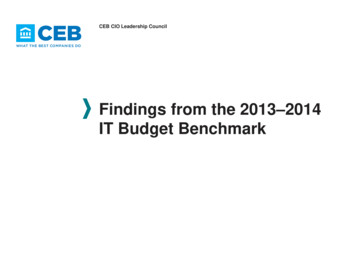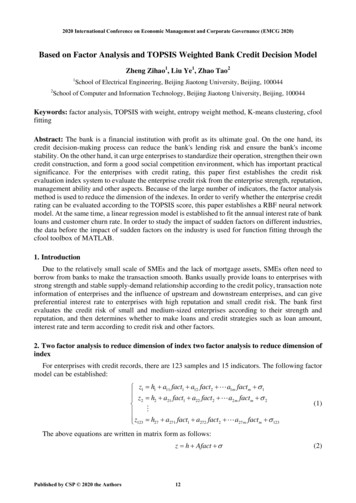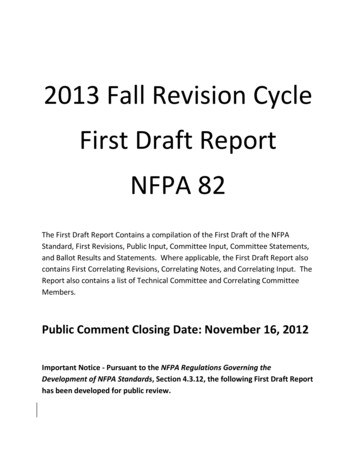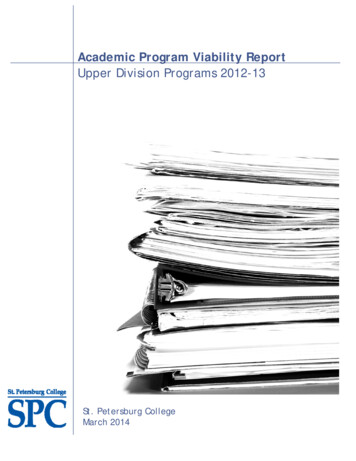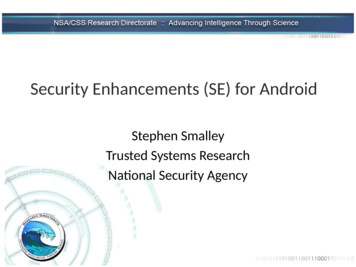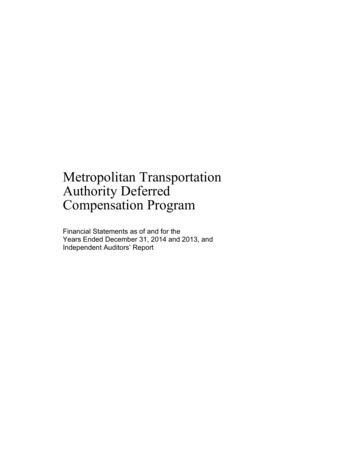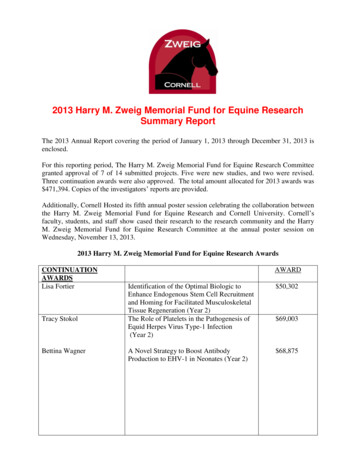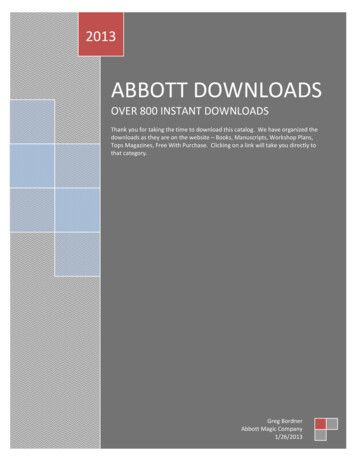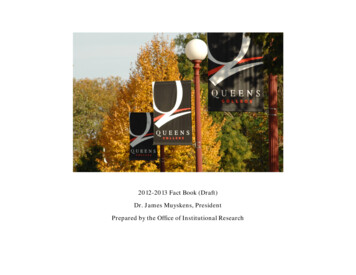
Transcription
2012-2013 Fact Book (Draft)Dr. James Muyskens, PresidentPrepared by the Office of Institutional Research
Executive Summary 2012-13The Queens College Fact Book is compiled by the Office of Institutional Research to show trends in student admissions, enrollment, retention and graduation, andoutcomes on licensing exams as well as college divisional and departmental data. Additionally, it provides profiles of the faculty and the undergraduate andgraduate student populations. Below are some highlights:Fall 2012 Enrollment, FTEs, Full-time, Part-time Attendance, Race/Ethnicity Queens College had a total enrollment of 20,100 students. This includes 16,187 undergraduate students and 3,913 graduate students. Queens College had an Undergraduate FTE of 12,500 and a Graduate FTE of 2,043. The total FTE was 14,543. In Fall 2012 semester, 19,032 first-time, first-year students applied, 7,045 students were admitted, and 1,449 freshmen were enrolled. The acceptance rate(the ratio of the number of students admitted to the number of applicants) was 37%. These data are based on the University multiple admissions methodology. Of all undergraduates, 69.8% (11,300) attended full-time, and 30.2% (4,887) attended part-time. The imputed race/ethnicity1 for undergraduate students was 7.8% black/non-Hispanic, 25.2% Asian/Pacific Islander, 17.3% Hispanic, 45.1% white/non-Hispanic,and 0.1% American Indian or Native Alaskan, 4.6 non-resident alien. (IPEDS Categories) Undergraduate students gender was 57.6% female, 42.4% male; and for graduate students, 72.2% female, 27.8% percent male. The percentage of first-year full-time freshmen who entered QC in Fall 2011 and returned in Fall 2012 (first year freshmen retention rate) was 87%.Fall 2012 Freshmen and Transfer Student Highlights Of the 1,449 first-semester freshmen in Fall 2012, 43.5% were full-time men, 55.0% full-time women, 0.75% part-time men, and 0.75% part-time women. The mean college admissions average2 for first-time freshmen was 86.5, and the mean SAT score was 1,1013 . Of the 1,340 first-semester transfers in Fall 2012, 38.7% were full-time men, 41.0% full-time women, 9.9% part-time men, and 10.4% part-time women.1ImputedRace/Ethnicity2: CUNY asks students on their application forms to indicate their race/ethnicity using IPEDS defined categories. Students who respond “Other” and those who do not respond areassigned a race/ethnicity category. This designation is based on a variable comprised of the student’s surname and zip code, which are matched with known data about populations in Queens and the NewYork metropolitan area.2Mean College Admissions Average: A statistic computed by the CUNY Admissions Office based on selected academic courses from the students’ high school records.3 Includes recent college graduates from domestic High Schools and excludes SEEK students.
Executive Summary 2012-13Degrees Awarded and Graduation Rates In 2011-2012, 3063 bachelor’s degrees, 263 Post-baccalaureate Certificates, 1247 Master’s degrees, and 92 Post Masters Certificates were awarded. Therewere 395 Second majors for bachelor’s degree students. Sept. 2006 Full-time Freshmen, 893 (54.9%) graduate with Bachelor’s Degrees, 362 (22.3%) transferred, or left Queens College and 110 (6.8%) were stillenrolled. 262 (19.2%) did not enroll or left the City University of New York. For additional data on graduation rates, go /CURRENT CUNY DATA BOOK RET GRAD SYS INSTAdditional information on Graduation Rates by gender and ethnicity can be found at EOA%20DisclosuresPopular Majors The five undergraduate majors with the largest enrollment were Accounting, Psychology, Elementary & Early Childhood Education, Economics, and Sociology. The five Masters level graduate programs with the largest enrollment were Library Science, Teacher of Special Education, Accounting, Urban Affairs, andChildhood Education.Teacher Certification Exams Preliminary Title 2 data has been posted for 2011-2012 at /Documents/NYSTCE -Final Report 20112012.pdfFaculty Of the 609 full-time faculty, 55.3% were male, and 44.7% female. Of the 337 full-time male faculty, 42.4% were professors, 22.6% associate professor, 25.2%assistant professor, and 9.8% lecturer/instructor. Of the 272 full-time female faculty, 23.4% were professors, 23.8% associate professor, 38.3% assistantprofessor, and 14.5% lecturer/instructor. The average salary for male professors (n 148) is 115,060.52, associate professors (n 74) is 90,104.64, assistant professors (n 80) is 74,657.26,instructors (n 3) is 63,246.67, and lecturer (n 32) is 67,206.34.The average salary for female professors (n 67) is 108,053.70, associate professors (n 73) is 88,935.88, assistant professors (n 88) is 74,487.99,instructors (n 3) is 59,392.67, and lecturers (n 41) is 66,374.00
QUEENS COLLEGE AND ITS MISSIONGeneral Information 2012-2013Established in 1937 to offer a strong liberal arts education to working-class people, Queens College has grown to an enrollment of 20,100 students in Fall 2012,including 16,187 undergraduate and 3,913 graduate students. Of the Fall 2012 undergraduate students, 69.8% attended full-time and 30.2% attended part-time.Of the graduate students, 10.6% attend full-time and 89.4% part-time. While known for its strong liberal arts emphasis, Queens College also offers professionaldegrees on both the graduate and undergraduate levels. Students come from nearly 170 different countries and speak over 110 different languages.Queens College is listed in the Princeton Review’s The Best 377 Colleges, and as one of the “Best Public Universities-Master’s” institutions in U.S. News and WorldReport’s America’s Best Colleges, which includes Queens in the top tier of Regional Northeast master’s-level colleges. Queens College was cited by the WashingtonMonthly as a public institution offering the “best bang for buck”. The Monthly’s “best bang for the buck” rankings also take into account factors such as percentageof students receiving pell grants, graduation rates of at least 50%, the graduation rate must meet or exceed the rate that would be statistically predicted given theircriteria, schools must have a student loan default rate of 10 percent or less. The Washington Monthly chooses to stress factors such as the share of studentsreceiving need-based Pell grants, predicted versus actual graduation rates, research expenditures and Peace Corps and ROTC participation, among others. Inaddition, Queens College also is listed online under the Best Graduate Schools for Library Information Science Programs, Fine Arts Schools, Psychology Schools,and Speech Pathology Schools.The 1995 Queens College Statement of Purpose is as follows: The mission of Queens College is to prepare students to become leading citizens of an increasingly global society. The college seeks to do this by offering itsexceptionally diverse student body a rigorous education in the liberal arts and sciences under the guidance of a faculty that is dedicated to the pursuit ofexcellence and the expansion of the frontiers of knowledge. Its goal is that students learn to think critically, address complex problems, explore various cultures,and use effectively the full array of available technologies and information resources. Within a structured curriculum and in an atmosphere of collegiality and mutual respect, the college fosters an environment in which students learn theunderlying principles of the humanities, the arts, and the mathematical, natural, and social sciences. The college also prepares students in a variety ofprofessional and pre-professional programs that build upon and complement the liberal arts and sciences foundation. Recognizing the special needs of a largely commuting student population, the college strives to create a broad range of intellectual and social communities. Thecollege offers a spectrum of curricular and co-curricular programs that serve individuals and distinctive student constituencies. In support of advanced study in the liberal arts and professions, the college offers a variety of master’s degree and certificate programs. In particular, the collegerecognizes and accepts its historic responsibility for providing high-quality programs for the pre-service and in-service education of teachers. As a partner with the University’s Graduate Center, the college provides faculty and resources in support of the University’s mission in doctoral education andresearch. The college employs University graduate students and prepares them for careers in higher education and research, and it supports faculty who serve asmentors for doctoral students and engage in related scholarly activities. For its faculty, the college seeks productive scholars, scientists, and artists deeply committed to teaching. It endeavors to enhance the teaching effectiveness offaculty and to encourage their research and creative work. The college recognizes the importance of a diverse faculty responsive to the needs and aspirations ofstudents of all ages and backgrounds.
General Information 2012-2013 As a public institution, Queens College provides affordable access to higher education and embraces its special obligation to serve the larger community. It is asource of information in the public interest, and it is a venue for cultural and educational activities serving the general public. Through its graduates’contributions to an educated workforce and through the leading roles they assume in their local communities, the college is vested in the economic future andvitality of New York. As one of the most culturally diverse campuses in the country, Queens College faces special challenges and opportunities. By balancing tradition and innovationin the service of this diversity, it represents the future of the nation.Middle States Commission on Higher Education AccreditationQueens College is proud to have received notification from the Middle States Commission on Higher Education on November 15, 2012 thatthe Periodic Review Report was accepted and that our accreditation was reaffirmed. The Middle States Commission also commended theinstitution for the quality of the Periodic Review Report. The next evaluation visit is scheduled for 2016 - 2017. This result is posted on theMiddle States Commission on Higher Education website at http://www.msche.org/Additional Accreditation BodiesBelow is the list of additional accreditation bodies. Academy of Nutrition and Dietetics, Accreditation Council for Education in Nutrition and DieteticsAmerican Alliance for Health, Physical Education, Recreation and Dance (AAHPERD) / National Association for Sport and Physical Education (NASPE)American Chemical SocietyAmerican Psychological Association, Commission on AccreditationAmerican Speech-Language-Hearing Association, Council on Academic Accreditation in Audiology and Speech-Language PathologyAmerican Association of Family and Consumer SciencesAmerican Audiology and Speech Language PathologyAssociation for Childhood Education International (ACEI)American Council on the Teaching of Foreign Languages (ACTFL)Council for Exceptional Children (CEC)Council for Accreditation of Educator PreparationCouncil on Academic AccreditationAccreditation/Approval for Dietetics EducationAmerican Library AssociationEducational Leadership Constituent Council (ELCC)International Reading Association (IRA)National Council for Accreditation of Teacher EducationNational Association for the Education of Young Children (NAEYC)National Association of School Psychologists (NASP)National Council for the Social Studies (NCSS)National Council of Teachers of English (NCTE)
National Council of Teachers of Mathematics (NCTM)National Science Teachers Association (NSTA)General Information 2012-2013National Association of Schools of Music, Commission on AccreditationNew York State Board of Regents, and the Commissioner of EducationTeachers of English to Speakers of Other Languages (TESOL)Strategic Planning and Its Importance at Queens CollegeQueens College has embarked on its second Strategic Planning Process while President Muyskens’ has been at the helm. The current plan is shown in the an/ with the Vision, purpose, values, Stakeholders and partners, and key themes and Strategic Enablers listed.As of Fall 2012, Queens College is thriving, with 20,100 undergraduate and graduate students. It has a national reputation for its arts and sciences and preprofessional programs. The college undertook its strategic planning process from a position of significant strength.The Strategic Plan was developed through a broadly consultative and inclusive process. The plan delineates a set of specific strategic objectives for the next fiveyears—Queens celebrated our 75th anniversary in 2012—as the first steps toward the realization of its longer-term vision. In order to move assertively toward therealization of our centennial vision, over the next five years the college has embraced the following key themes:1. Make key strong programs world-class by offering academic programs of exceptional quality; recruiting, developing, and retain a faculty of international quality2. Educate our Students to be global citizens by Inspiring our students to develop their full potential Infuse our academic programs with a global perspective3. Build a culture of community by Strengthening the college experience of our students Making our campus welcoming, secure and “green” Increasing our visibility and recognition Be a catalyst for the development of the BoroughThe Strategic Plan and Recent AchievementsAccomplishments can be found at dfThe Queens College Strategic Plan can be found at http://www.qc.cuny.edu/about/Documents/qc strategic plan 2008-2013.pdfThe New Strategic Planning endeavor
General Information 2012-2013A new Strategic Plan has been introduced and the new plan will be available on the website after President Muyskens gives his final approval. Strategic planningtopic areas include the following: Weaving Transnational Connections, Launching Graduates into the Global Future, Nurturing Inquiry and Creativity of a WorldClass Faculty, Enriching our Local Community, and Budget. All of the Strategic Planning Committees met at the end of April 2013 to review and discuss thevarious plans and to look to the future of the college and how it will meet its new challenges.Additional College wide endeavorsFoundations of ExcellenceThe College embarked on a major undertaking in 2011-2012 working with the Gardner Institute on the Foundations of Excellence initiative. A set of committeesinvolving almost 100 students, faculty, and staff made specific recommendations for improving the success of new freshman and transfer students. Therecommendations of those committees are being implemented over five years. The implementation plan involves working with units around campus to: removeobstacles for freshman and transfer students, improve curricular and student success information delivered online, engage faculty in the teaching of first-yearstudents, incorporate first-year students in assessment metrics, and expand experiential education and honors programs. For more information:http://www.qc.cuny.edu/about/FoEQueens College offers the following programs for nontraditional students: Search for Education, Elevation, and Knowledge (SEEK) is an admissions alternative and educational opportunity program. Its mission is to serve withdistinction students with academic aspirations who are educationally underprepared and have low incomes. The SEEK Program helps students achieveacademic success by providing support and assistance in four major areas: instructional, financial, counseling, and tutorial. Adult Collegiate Education (ACE) is an accelerated bachelor’s degree program for high school graduates age 25 and older; GEDs and foreign equivalencies arealso accepted. Upon completing eight liberal arts courses that fulfill most of Queens College’s distribution requirements, ACE participants may apply for up to 36tuition-free life achievement credits based on personal or professional experience. Thereafter, these students choose majors and electives. For more information,visit s/default.aspx. The Labor Education and Advancement Project (LEAP), under the auspices of the Joseph S. Murphy Institute’s Center for Labor, Community, and Policy Studies,offers a wide range of educational services to working adults and to the labor community. With the cooperation of a number of New York City unions, the LEAPoffice on campus assists union members returning to school in pursuit of undergraduate and graduate degrees, and is dedicated to providing students with theopportunity to analyze and understand the world of work, the economy, and society in general, and to develop the skills and intellectual foundation necessary forcareer advancement.Prospective students with a high school diploma and who are 25 years of age or older may be eligible for admission to the LEAP program. Most of the studentswho enroll through LEAP receive tuition support from their unions. Matriculated LEAP students are eligible to enroll in an accelerated curriculum, including aseries of four-credit and six-credit interdisciplinary seminars in the arts, sciences, and social sciences (some courses are shared with the ACE program; others
General Information 2012-2013are offered specifically by LEAP). LEAP students select an academic major and electives, and may earn credits for life experience. Weekend College (WC) offers both the General Education (GE) component of the undergraduate degree (which includes courses primarily taken in the freshmanor sophomore year) and all courses needed for completion of a major in accounting, interdisciplinary liberal arts, psychology, sociology, or Spanish. For all othermajors, students must add some day and evening courses to the Weekend College schedule. Weekend College also provides some opportunities to take onlineclasses. For more information, visit http://www.qc.cuny.edu and link to Weekend College.
Faculty and Students 2012-13FACULTYQueens College students benefit from an outstanding faculty of distinguished scholars. Queens College faculty receive numerous fellowships, awards, and researchgrants, and many are national and international leaders in their fields. In addition to a strong commitment to teaching, faculty enjoy sharing insights with studentsin labs and informal classroom discussions. Many faculty participate in the doctoral programs of the CUNY Graduate Center. In several departments, the first 30credits of graduate work at the master’s level constitute the first year of the doctoral program. Many CUNY doctoral students work under the direct supervision ofQueens College faculty members. The college also has recently established a program through which undergraduate students may participate in researchsupervised by Queens College faculty. The College is supporting teaching excellence with the aid of the Center for Teaching and Learning. For more information,visit http://www.qc.cuny.edu/ctl. Center for Teaching and Learning offers opportunities outside the department structure for faculty to discuss and learn about allaspects of teaching and learning, including assessment of student learning and innovations in technology. Curricular work is further supported by our Office ofGeneral Education, which oversees the development, management, and coordination of our liberal arts curriculum.The college is committed to insuring that faculty salaries and fringe benefits are competitive. The college budgeted 54,312,550 for full-time faculty salary outlays forits lecturers, instructors, assistant, associate, and full professors. Additional release time has been built into the contract for new faculty to allow them toconcentrate on their research. The college maintains a database on its website detailing faculty accomplishments, publications, and FacultyScholarship.aspxThe Center for Teaching and Learning, which offers opportunities outside the department structure for faculty to discuss and learn about all aspects of teaching andlearning, including assessment of student learning and innovations in technology. Curricular work is further supported by our Office of General Education, whichoversees the development, management, and coordination of our liberal arts curriculum.In Fall 2012 the Queens College instructional staff included 609 full-time faculty in professor, instructor, and lecturer titles (including substitutes and visitingfaculty) and 899 part-time instructional staff: Of the 537 professoriate ranked faculty, 355 (66%) of the full-time faculty are tenured , 156 (29%) are in tenure-trackpositions, and 26 (5%) are nontenure-track faculty; 85% have doctorates or the highest degrees in their fields. The college has a number of distinguished professorswho have been recognized for their exceptional records of scholarly accomplishment. These include Robert Bittman, membrane biochemist; Joshua Freeman, anexpert in American Labor History; Azriel Z. Genack, internationally known physicist of random processes; Fred Gardaphe, leading expert in the field of ItalianAmerican studies; Jeffrey M. Halperin, developmental neuropsychologist; Samuel C. Heilman, sociologist specializing in Jewish studies; George Hendrey, geologistspecializing in global change, ecology, and the carbon cycle; Kimiko Hahn, award-winning poet; Yunping Jiang in Mathematics specializing in Dynamical Systemsand Complex Analysis ; Pyong Gap Min, an expert on Asian Americans, and Korean Americans in particular, whose work is considered the standard reference on theAsian-American/Korean-American experience; Carl A. Riskin, an authority in development economics and environmental economics; Morris Rossabi, a notedhistorian specializing in the history of China and its external relations, particularly with Mongolia, and integrating the study of China into that of world history; andStephen Steinberg, sociologist specializing in race and ethnicity studies.
Faculty and Students 2012-13STUDENTSQueens College is proud of its exceptionally diverse student body. Our students hail from nearly 170 countries around the world and speak over 110 languages anddialects.In Fall 2012, the College had16,187 Undergraduate Students and 3,913 Graduate Students comprising 20,100 Students. Of these, 1,324 were new freshmen, 125were new SEEK Students, and 2,205 were new Transfer Students. There were 1,072 new Graduate Students Enrolled. Five-Year Trends in Total Fall and Springis available at R.5YR.TREND.FALL.SPRING.pdfQueens College enrolled undergraduate students in Fall 2012, whose race/ethnicity was 8.1% black, 25.4% Asian, 17.5% Hispanic, 48.9% white/non-Hispanic, and0.1% American Indian or Native Alaskan. Women make up 57.6% of the undergraduate students and 72.2% of the graduate students. 69.8% of theUndergraduates attend Full-time, while 30.2% attend Part-time. 10.6% of the graduate students attend full-time and 89.4% attend part-time.The Queens College Foundation provides merit-based scholarships for entering students, and the college offers honors programs. The Macaulay Honors College atQueens College (MHC) provides outstanding students with unique and challenging learning experiences, including study abroad, internships, and fourinterdisciplinary seminars designed to enhance their understanding of the people and institutions of New York City. Students also can take part in such specialprograms as SEEK (Search for Education, Elevation, and Knowledge), ACE (Adult Collegiate Education), and LEAP.There are many Study Abroad Opportunities for Queens College Students. The most recent can be found broad/ "There is no better—or more enjoyable—way of learning about the world than through travel. Infact, Queens College encourages all students to leave New York City at some point in their academic careers, whether or not they speak a foreign language; manyclasses are offered in English. Study Abroad options range from relatively short summer and winter intersession courses to programs that last a semester or two.Exchange Programs allow Queens College students to participate for up to a year in the United States, Canada, France, Italy, or Japan.”In 2011-2012, 3063 bachelor’s degrees, 263 Post-baccalaureate Certificates, 1247 Master’s degrees, and 92 Post Masters Certificates were awarded. There were395 Second majors for bachelor’s degree students.
Alumni 2012-13Queens College can boast over 100,000 alumni since its first graduating class in 1941. About 85% live in the New York metropolitan area, but alumni also can befound in every state of the United States and in several foreign countries. They have excelled in a variety of careers as accountants, actors, anthropologists,archaeologists, artists, bankers, biologists, business executives, chemists, comedians, dentists, doctors, educators, engineers, entertainers, journalists, lawyers,legislators, manufacturers, musicians, poets, real estate developers, research scientists, and writers.Queens counts among its alumni such outstanding graduates as:Gary Ackerman, CongressmanJoy Behar, comedian and authorMichael Berenbaum, former Director, United StatesHolocaust Research InstituteJay Bushinsky, 1010 WINS correspondent; Edwin M.Cooperman, Chairman and CEO, EdmarcInvestmentsJoseph Crowley, CongressmanMichael Goldstein, former Chairman and CEO, Toys“R” Us;Reri Grist, opera starMarvin Hamlisch, Oscar-, Tony-, and GrammyCarol Hochman, CEO, Triumph Marketing SusanIsaacs, novelist and screenwriterDavid Khalili, Chairman, Maimonides FoundationCarole King, singer and songwriterIra Lampert, Managing Member, Singkin HoldingsNathan Leventhal, former President, Lincoln CenterAllan Z. Loren, former Chairman and CEO, Dunn &Bradstreet CorporationHelen Marshall, Queens Borough President; ElseHolme lund Minarik, “Little Bear” series authorEugene Murphy, retired Vice Chairman, GeneralElectricMary Murphy, Emmy-winning TV anchor andreporter, WB 11Juliet Papa, WINS Radio reporterWarren Phillips, former publisher, Wall StreetJournalRay Romano, comedianJerry Seinfeld, comedianBright Sheng, composer and classical pianist PaulSimon, musical artist and composer RobertSorrentino, President, Bertelsmann, Inc.William Thiele, Senior Vice President, General ReCorporationCharles Wang, Chairman Emeritus, ComputerAssociates International, and owner, NY IslandersMany other graduates have distinguished themselves in their fields. Queens College alumni serve in the national, state, and city legislatures.
IPEDS, PMP, HEOA Disclosures, Finance, and Facilities 2012-13INTEGRATED POSTSECONDARY DATA SYSTEM REPORTS (IPEDS)The University posts the Integrated Postsecondary Data System Reports on their public website by College and subject area. For a historic look byCollege, visit http://www3test.cuny.edu/export orts/integrated.htmlPERFORMANCE MANAGEMENT PROCESSThe City University of New York follows a performance management process (PMP) that links planning and goal setting by theUniversity and its colleges and professional schools, measures annual progress towards key goals, and recognizes excellentperformance. The latest University Goals and Targets as well as the links to the latest College’s final report have been postedto the University Website. For more information about this process, visit the following t/accountability/PMPUniversityReport 2012-13 Prelim.pdfHigher Education Opportunity Act (HEOA) CUNY n/offices/ira/ir/reports/HEOA.htmlTHE QUEENS COLLEGE REPORT IS AVAILABLE lor/performance -goals/pmp gt report 2012-13 QNS final.pdfFINANCESelected financial data for Queens College from the Integrated Postsecondary Education Data System (IPEDS) on Revenues and Expenditures ispresented in tabular form in an Appendix. IPEDS gathers information from every postsecondary educational institution that participates in federalstudent financial aid programs, pursuant to the Higher Education Act of 1965, as amended. Further information about IPEDS can be found athttp://nces.ed.gov/ipeds/about/.
IPEDS, PMP, HEOA Disclosures, Finance, and Facilities 2012-13FACILITIESThe college’s main campus consists of 36 buildings on several acres and is lined with trees surrounding grassy open spaces. Some of the originalstucco-and-tile buildings from the early 1900s still stand, contributing to the pleasantly eclectic style of the campus. A major building program hasgreatly expanded classroom and research facilities as well as spaces for varied campus activities. Facing Melbourne Avenue is the Science Building,housing teaching and research laboratories, offices, and classrooms. At the western edge of the Quadrangle is the Benjamin S. Rosenthal Library.Facing Reeves Avenue are FitzGerald Gymnasium, home to the Athletics and Recreation offices, and the Music Building. Klapper Hall is home tothe Art and English Departments as well as the Godwin-Ternbach Museum. On the southern edge of the Quad are Colwin Hall, Delany Hall, andRemsen Hall, which has a new research wing. West of the Library are an expanded parking facility and va
Queens College is listed in the Princeton Review's The Best 377 Colleges, and as one of the "Best Public Universities-Master's" institutions in U.S. News and World Report's America's Best Colleges, which includes Queens in the top tier of Regional Northeast master's-level colleges.Queens College was cited by the Washington Monthly as a public institution offering the "best bang .
